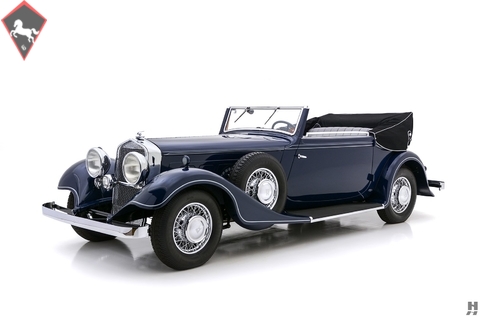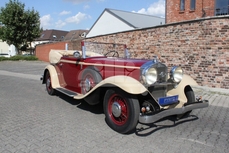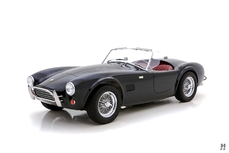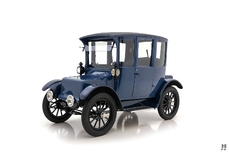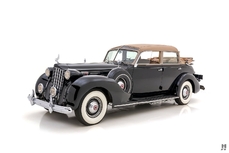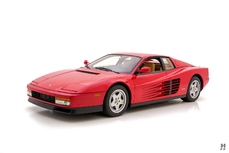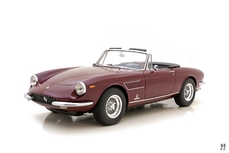Horch 8 5 ltr. Typ 480/500/500A/500B/780/780B 1934
Allgemeine Beschreibung :
Once the crown jewel of the Auto Union Empire, Horch stands proudly among the German motoring industry's most prestigious classic era marques. August Horch founded his eponymous firm in 1900, and it steadily grew in prominence thanks to a commitment to innovation and engineering excellence. Horch went head-to-head with the likes of Daimler and Mercedes through the 1920s and 1930s, joining Audi, DKW, and Wanderer to form Auto Union in 1932. Later in the 1930s, the Auto Union Grand Prix team famously locked horns in a fierce battle with Mercedes-Benz for supremacy on European racing tracks.
In March of 1932, Horch introduced the powerful new 700-series, a suitable flagship for the new Auto Union concern. Buyers could select one of three versions of the new overhead-cam inline eight-cylinder engine, designed in-house by Fritz Fiedler. At the top of the model range sat the 4.9-liter Type 780, which produced 100 horsepower with exceptional refinement, and could propel the 780 to at 125 km/h or more depending on the coachwork. Produced from 1932 to 1934, Horch sold just over 300 examples of the elegant and refined 780. The final 83 cars were designated Type 780 B, featuring a revised chassis with a 30mm wider track for improved handling and stability.
Horch employed the finest German coachbuilders to produce bodies worthy of the prestigious Type 780 chassis, including Bauer, Erdmann & Rossi, and their favored karosserie; Gläser of Dresden. Gläser created bodies for a wide range of marques, including Opel, Cadillac, and Wanderer, but they reserved some of their most exceptional work for Horch.
This rare and elegant Horch is one of a handful of late-production Type 780 B models in existence, featuring gorgeous sport cabriolet coachwork by Gläserkarosserie, GmbH. This stunning automobile was meticulously restored to a very high standard by a noted marque specialist, with subtle improvements for relaxed, enjoyable touring. This car was the third-from-last 780 B chassis constructed, delivered to an unknown owner in 1934. After World War II, it made its way to Belarus, where it spent the next six decades quietly hidden away. At the time of its discovery in 2005, the original coachwork was long lost, so the restorers paired it with this marvelous and well-preserved Sportcabriolet body, understood to be a Gläser creation first fitted to a Horch Type 710 chassis.
The exhaustive nut-and-bolt restoration consumed seven years and is documented in an accompanying booklet of photographs. The structural woodwork was in remarkably good condition, and the restorers took particular care in preserving as much as they could of the coachwork. They painstakingly rebuilt the drivetrain, fitting the engine with new bearings, pistons, and modern-style oil seals wherever possible. They meticulously made new fuel lines in copper and the exhaust system in high-quality stainless steel. In the interest of drivability, they adapted a modern Getrag 5-speed synchromesh gearbox to significantly reduce driver effort and transform the Horch into a marvelous and highly-capable long-distance tourer.
Finished in a stunning shade of royal blue with gray coach lines, this magnificent 780 B has an imposing presence. The paintwork is finished to concours-quality standards, with excellent quality bodywork and fit. Chrome plating is superb all around, and details include gorgeous chrome wire wheels with black wall Michelin tires, a mesh radiator stone guard, and dual side-mount spares. It is a marvelous example of Teutonic elegance, with the skirted fenders and blind-quarter roof treatment emphasizing the low and sporting profile.
Opening one of the massive, vault-like doors reveals a lovely five-passenger cabin trimmed in light gray leather upholstery with burgundy piping. As with the exterior, the execution of the interior is superb. The dash and door caps feature gorgeous blonde-colored woodwork with cream banding to give the cabin a lighter feel. Broadcloth lines the inside of the impeccably made canvas top, and dark gray carpets appear virtually new. Switches, controls, and instruments are in superb order, with the 5-speed pattern on the period style gear knob gives away the modern 'box fitted below.
The under-bonnet presentation is excellent, and the big eight beautifully detailed with lovely black enamel and chrome. The engine is spotlessly clean and tidy, with only the exhaust manifold showing signs of use. The chassis and undercarriage are also beautifully presented with excellent paint quality on the suspension and driveline components.
Upon completion of the seven-year project, this magnificent Horch debuted at the Jewels in the Park Concours d'Elegance in Schloss Dyck, Germany, where it won the trophy for Best Restoration. Presented in superb order throughout, this rare and beautiful Horch remains suited for concours display, while the thoughtful upgrades make it perfect for touring enjoyment. As a CCCA Full Classic, it is a wonderful choice for their CARavan road tours and similar events.
Offers welcome and trades considered
https://hymanltd.com/vehicles/6681
1934 Horch 8 5 ltr. Typ 480/500/500A/500B/780/780B is listed verkauft on ClassicDigest in St. Louis by Mark Hyman for $395000.
Fakten der Auto
Karosserietyp : Auto Marke : Horch Modell : 8 5 ltr. Typ 480/500/500A/500B/780/780B Hubraum : 0.0 Modelljahr : 1934 Karosstyp : Convertible Lage : Missouri
Verkauft
Angaben Zum Verkäufer
Verkauft
People who viewed this Horch 8 5 ltr. Typ 480/500/500A/500B/780/780B also viewed similar Horch listed at ClassicDigest
Other cars listed for sale by this dealer
über Horch
Horch, der deutsche Hersteller von Luxusautomobilen, stand oft im Schatten seiner bekannteren Konkurrenten wie Mercedes-Benz und BMW. Dennoch hatte das Unternehmen eine einzigartige und bemerkenswerte Geschichte in der Welt der Luxusautos.Gründung von Horch:
Horch wurde 1904 von dem visionären Ingenieur August Horch gegründet. Das Unternehmen hatte seinen Sitz in Zwickau, Deutschland, und erlangte schnell einen Ruf für die Herstellung hochwertiger, fein gefertigter Automobile.
Rivalität mit Mercedes-Benz:
Eine der größten Herausforderungen, denen sich Horch gegenübersah, war der harte Wettbewerb mit Mercedes-Benz, dem Riesen unter den deutschen Luxus-Automobilherstellern. Mercedes-Benz war allgemein bekannt, und seine Autos standen für Luxus und Leistung. Diese Rivalität stellte Horch oft in den Schatten.
Ingenieursexzellenz:
Horch war jedoch in der Ingenieursabteilung keineswegs schlecht. Das Unternehmen war für mehrere Innovationen verantwortlich, darunter die Einführung eines Achtzylinder-Motors. Diese Ingenieursleistungen trugen dazu bei, dass Horch Anerkennung für seine Leistungsfähigkeit und Zuverlässigkeit erlangte.
Verschmelzung zur Auto Union:
Im Jahr 1932 fusionierten Horch, zusammen mit Audi, DKW und Wanderer, zur Auto Union. Die vier ineinander greifenden Ringe im Logo von Audi symbolisierten diese Union. Unter dem Dach der Auto Union produzierte Horch weiterhin Luxusfahrzeuge und trug zum allgemeinen Erfolg der Gruppe bei.
Herausforderungen und der Zweite Weltkrieg:
Der Zweite Weltkrieg führte zu erheblichen Unterbrechungen in der Produktion von Horch. Die Nachkriegszeit brachte ebenfalls wirtschaftliche Herausforderungen mit sich, da das Unternehmen versuchte, seinen Vorkriegsglanz wiederzugewinnen.
Ende des Weges:
Im Jahr 1958 wurde die Auto Union von Daimler-Benz, dem Mutterkonzern von Mercedes-Benz, übernommen. Dies markierte das Ende der Marke Horch. Ihr Erbe wurde in die größere Auto Union-Familie integriert.
Horch hat vielleicht nicht das gleiche Maß an internationaler Bekanntheit wie Mercedes-Benz erreicht, spielte jedoch eine bedeutende Rolle in der Geschichte deutscher Luxusautos. Seine Hingabe zur Ingenieurkunst und zum Luxus trug zum allgemeinen Ruf der deutschen Automobilfertigung bei. Obwohl es im Schatten seiner Konkurrenten verweilte, lebt das Erbe von Horch als Zeugnis für die goldene Ära der Automobilhandwerkskunst in Deutschland fort. Es erinnert daran, dass die Geschichte des Automobils nicht nur von den großen Namen geprägt ist, sondern auch von den unsunglichen Helden, die ihre eigene unauslöschliche Spur hinterlassen haben.
